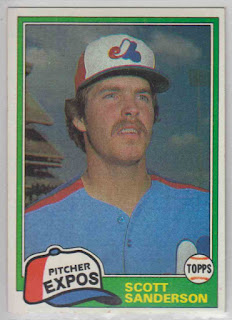I made another online purchase recently - I guess all this time inside has me surfing the web too much. One thing I had occasionally looked into doing was getting the old Topps baseball stickerbooks. My introduction to baseball was the 1986 Topps stickerbook when I was nine years old. I didn't actually start collecting cards until the next year. I had the Topps baseball stickerbooks from 1986-1989, the Topps football stickerbooks from 1986 and 1987, and the Panini baseball sticker books from 1988 and 1989. Unfortunately I didn't keep any of them. Over the years I have accumulated stickers from various card acquisitions, and would regret not having the books to put them in.
Recently I saw a lot of 1981-1990 Topps stickerbooks - the entire Topps run - with no stickers inside, for a very reasonable price (about $40 total). I jumped on that deal and now these are mine. Here are photos from each book (I've yet to put the stickers in - will do another post later with some of those).
Here is the first book, 1981. George Brett on the cover.
The insides were pretty simple, without the stickers it is just line drawings of ballplayers. Each stickerbook had a setup that was pretty similar throughout the ten year run - a page for each team, a page or two on the postseason and record breakers at the beginning, All Stars (with shiny stickers) in the middle, and top rookies at the end.
I won't show all the back covers but this one was pretty funny, with "quotes" from Reggie Jackson, George Brett and Jim Palmer. They're probably not real, but if you were to pick three stars from that time period who might actually have paid attention to cards, it would probably be those three. Maybe Gary Carter too.
Speaking of Carter, he's the cover boy for 1982.
The insides are more interesting with photos for the team pages.
1983 features Reggie Jackson.
The insides are very interesting. They have silhouettes which at least sometimes are clearly famous players from the history of each team. I recognized Cy Young for the Red Sox, Babe Ruth for the Yankees - below that's clearly Sandy Koufax for the Dodgers. Don't know who the Astro would be - Morgan? Cedeno? I think I will revisit these in some future posts.
1984 has an unusual action shot cover.
The inside team pages are pretty boring, so here is one alongside a more interesting "Stats Stats Stats" page.
1985 features the biggest star in baseball at the time, Dwight Gooden.
The insides were more boring team pages, so instead here is the really cool All Star insert page.
But why the strange airbrushing-in of a hat on the White Sox pitcher? This must be Rich Dotson, who had a Topps card so it's not like his face had to be airbrushed out for contract purposes.
1986 - my introduction to baseball.
Full color photos of the team stadiums were an instant nostalgia hit. Many of these photos are still my "head image" when I think of these parks.
1987 features Mike Schmidt on the cover.
The team pages are interesting, as the two teams are often mixed into one action painting. The made-up name on the Indians catcher always intrigued me.
1988 featured Mark McGwire on the cover.
Full-page photos for the team pages.
1989 cover with Orel Hershiser.
The insides had a small photo but lots of color.
Too bad I never picked up this great Don Mattingly cover in 1990. I guess once Topps realized I wasn't buying the sticker books anymore they stopped making them.
The insides were pretty similar to the previous year.
Later on I'll show photos with pages with the stickers in them. I'm not really looking to get more in trades but I've got quite a few I've accumulated over the years.
Owl's, O's (and a Jay) On A Mailday
6 hours ago

















